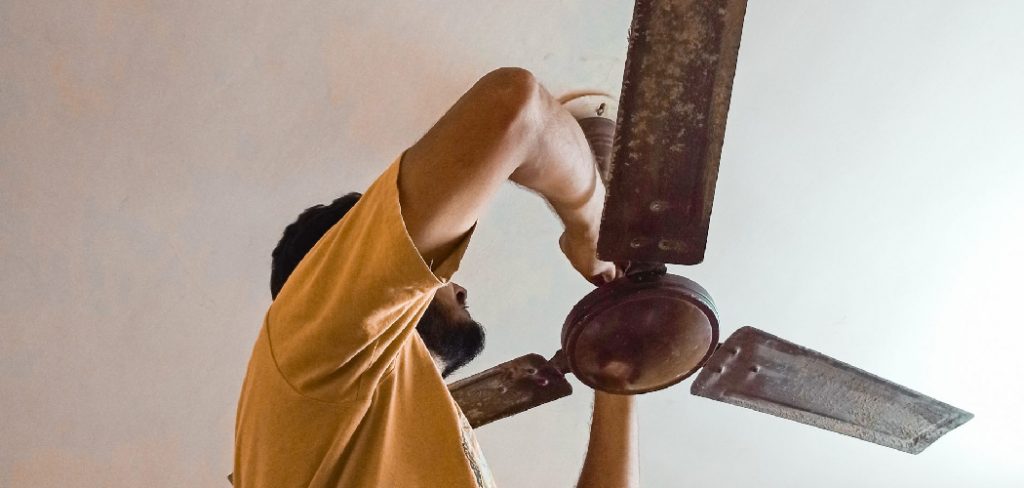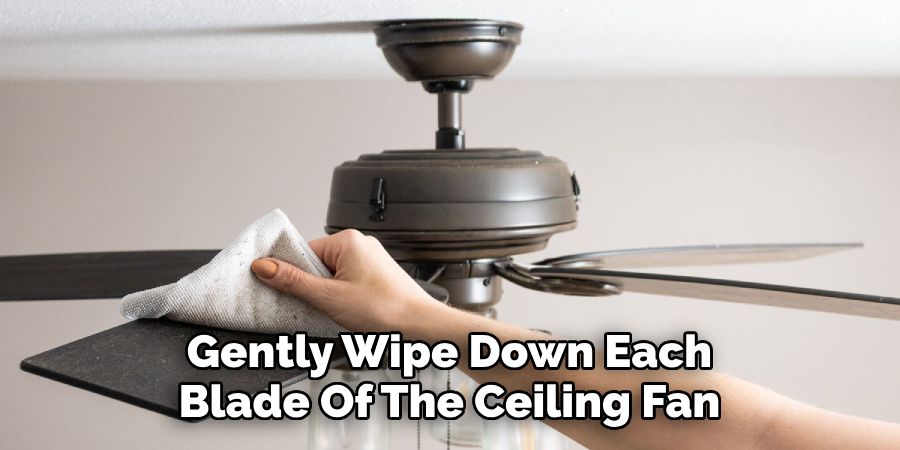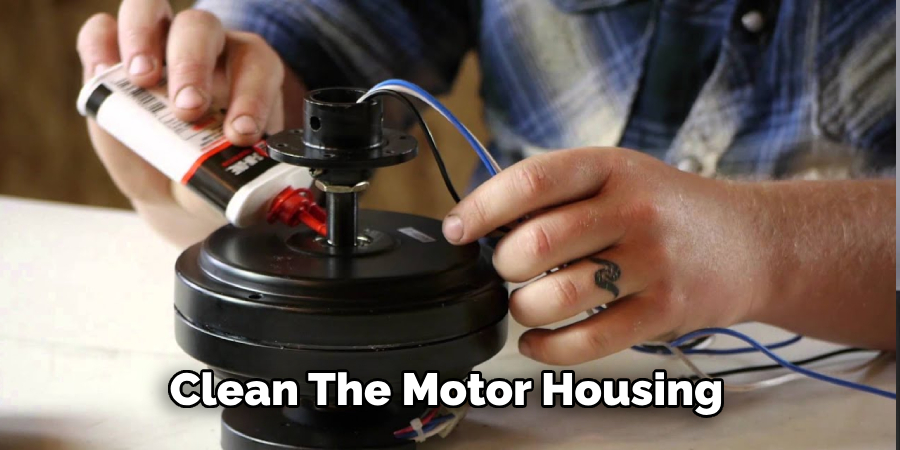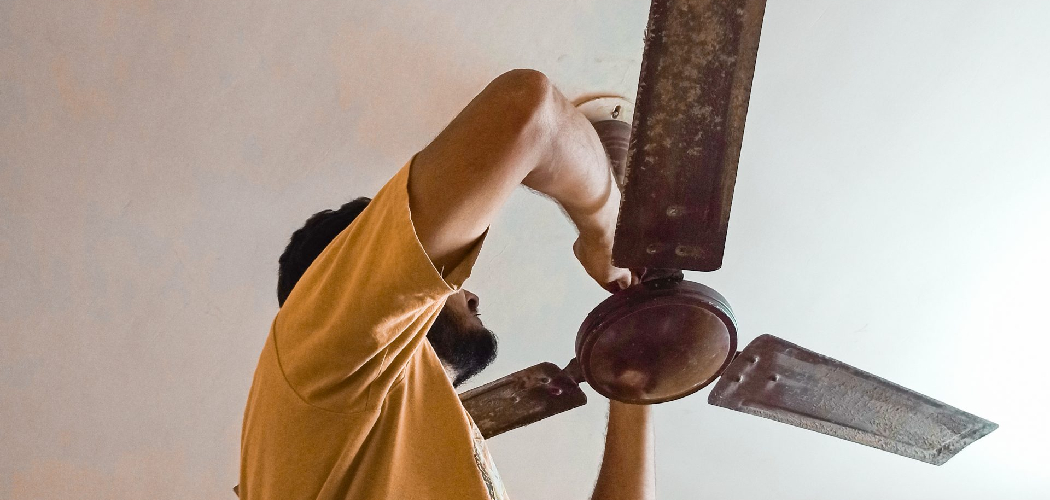Are your ceiling fans looking a bit worse for wear? Are they covered in dust and cobwebs, causing you to sneeze on hot summer days? Cleaning ceiling fans can be tedious work, but it does not have to be! With Vinegar as your secret ingredient, you’ll have them sparkling like new in no time.

Not only is vinegar cost-effective and eco-friendly, but this simple cleaning solution will also save you time so that you don’t have to spend hours trying to tackle the gunk yourself. Read along for the steps on how to clean ceiling fans with vinegar and keep your ceiling fans looking clean and fresh all year round.
Why Use Vinegar?
Vinegar has been a popular household cleaning agent for many years, thanks to its antibacterial, antifungal, and deodorizing properties. It is also a natural degreaser, making it an excellent option for tackling the build-up of dirt and grime on ceiling fans.
Additionally, vinegar is a budget-friendly alternative to store-bought cleaning products that may contain harmful chemicals. By using vinegar, you can save money and have peace of mind knowing that you are not exposing yourself or your family to potentially harmful substances.
Supplies You Will Need to Clean Ceiling Fans With Vinegar
Before getting started, make sure you have the following items on hand:
- A ladder
- A microfiber cloth or an old T-shirt
- A spray bottle
- White vinegar
- Water
- A vacuum with a brush attachment (optional)
Step-by-step Guidelines on How to Clean Ceiling Fans With Vinegar
Step 1: Prepare the Area
Before cleaning, make sure you spread out a cloth or newspaper underneath the ceiling fan to catch any drips or dust that may fall during the process. This will also make for easy clean-up afterward. Preparing the area will also prevent any damage to your floors or furniture. If you are using a ladder, ensure that it is placed on a stable and level surface.

Step 2: Turn off the Ceiling Fan
Before starting to clean, ensure that your ceiling fan is turned off to avoid any accidents. It would also be helpful to place a small piece of tape over the wall switch or remote control as an added precaution. Turning off the fan will also prevent any dust or grime from flying around while you clean. This is especially helpful for those who are sensitive to dust and allergens.
Step 3: Make the Vinegar Solution
In a spray bottle, mix equal parts of white vinegar and water. Shake well to combine the two ingredients. You can also add a few drops of essential oils such as lemon or eucalyptus for a fresh scent. Making the solution beforehand will save you time and allow you to focus on cleaning instead of mixing ingredients.
Step 4: Wipe Down the Blades
Using a cloth or an old T-shirt, dampen it with the vinegar solution and gently wipe down each blade of the ceiling fan. Make sure to cover both sides of the blades and pay special attention to any built-up dirt or grime. For stubborn dirt, you can use a vacuum with a brush attachment to loosen and remove debris before wiping it down with the vinegar solution.

Step 5: Clean the Fan Housing
Spray the remaining vinegar solution onto a cloth and wipe down the fan housing, including any motor or light fixtures. Be careful not to get any liquid into sensitive parts such as the motor or electrical components. If your fan has removable parts, such as a light fixture or blades, you can also soak them in the vinegar solution before wiping them down.
Step 6: Dry and Reassemble
After cleaning, use a clean cloth to dry off any excess moisture from the ceiling fan. Once dry, reattach any removed parts and give the fan a final wipe-down with a dry cloth to remove any remaining dust or grime. If your fan has a light fixture, make sure to turn off the power before reinstalling it.
Following these simple steps, you can keep your ceiling fans clean and fresh without the use of harsh chemicals. Regular cleaning with vinegar will also prolong the lifespan of your fan and prevent any build-up that may cause it to malfunction.
So next time your ceiling fans need a good cleaning, remember to reach for that trusty bottle of vinegar! Remember to regularly dust or vacuum your ceiling fans in between deep cleanings to maintain their shine and keep your home free of dust and allergens. Happy cleaning!

Additional Tips and Tricks to Clean Ceiling Fans With Vinegar
- For more effective cleaning, add a few drops of lemon or essential oils to the vinegar solution. This will not only help in removing dust and grime but also leave a fresh smell.
- If you have particularly stubborn stains or buildup on your ceiling fan blades, try using a mixture of equal parts vinegar and baking soda. Apply this paste onto the blades and let it sit for a few minutes before wiping it off with a damp cloth.
- To prevent dust from settling on your ceiling fan blades, use an anti-static spray after cleaning. This will help repel dust and keep your ceiling fans looking cleaner for longer.
- For hard-to-reach areas or high ceilings, consider using a microfiber duster or a long-handled cleaning tool with a microfiber cloth to clean your ceiling fans.
- In addition to using vinegar, you can also use rubbing alcohol or ammonia mixed with water as alternative cleaning solutions for your ceiling fan blades.
- Remember to always turn off and unplug your ceiling fan before cleaning. Safety should always be a top priority when dealing with electrical appliances. Regularly dusting and cleaning your ceiling fans not only keeps them looking clean and new but also helps improve their performance and prolong their lifespan.
- If you have multiple ceiling fans, it may be helpful to label the blades with a specific number or letter to ensure they are put back in the correct order after cleaning.
- Don’t forget to also clean the fan blades on both sides for thorough cleaning. Ceiling fan blades can accumulate a lot of dust and grime on both sides, so it’s important to clean them thoroughly for optimal results.
- In addition to cleaning the blades, don’t forget to clean the motor housing and any other visible parts of your ceiling fan. Use a damp cloth or vinegar solution to wipe down these areas as well.
- Lastly, remember to always properly dispose of any used clothes or cleaning materials. You can also opt for reusable microfiber cloths to reduce waste and save money in the long run.
Following these tips and tricks will help you effectively and efficiently clean your ceiling fans with vinegar, leaving them looking sparkling clean and functioning at their best. So the next time you notice dust buildup on your ceiling fan blades, reach for that trusty bottle of vinegar and get cleaning! Happy cleaning!

Frequently Asked Questions
How Often Should I Clean My Ceiling Fan?
Ceiling fans should be cleaned once a month to prevent dust buildup and maintain their efficiency. However, if the fan is used frequently or in a particularly dusty environment, it may need to be cleaned more often. It is important to regularly clean your ceiling fan to ensure it operates properly and to maintain good air quality in your home.
Can I Use Any Type of Vinegar for Cleaning My Ceiling Fan?
Yes, you can use any type of vinegar for cleaning your ceiling fan. White vinegar, apple cider vinegar, or even a mixture of both can work effectively. However, it is recommended to dilute the vinegar with water before using it to clean your fan.
Is Vinegar Safe to Use on Ceiling Fans?
Yes, vinegar is safe to use on ceiling fans. It is a natural and non-toxic cleaning agent that is safe for both humans and pets. However, it is always a good idea to wear gloves and protective eyewear when cleaning with any type of solution.
Can I Use Vinegar to Clean Other Parts of My Ceiling Fan Besides the Blades?
Yes, you can use vinegar to clean other parts of your ceiling fan besides the blades. It can be used on the motor housing, screws, and any other areas that may have accumulated dust. However, be sure to avoid getting any liquid into the electrical components of the fan.
How Do I Clean the Blades Without Them Drooping Down?
To clean the blades without them drooping down, you can use a pillowcase or a microfiber cloth. Simply slide the pillowcase or cloth over each blade and gently wipe away any dust or dirt. This will prevent the blades from drooping and also catch any debris that may fall while cleaning.
Conclusion
Knowing how to clean ceiling fans with vinegar can save you time and money, as well as help improve the air quality in your home. By regularly cleaning your ceiling fan with vinegar, you can maintain its efficiency and prolong its lifespan. It is a simple and natural solution that is safe for both you and your fan. So next time you notice your ceiling fan looking dusty, grab some vinegar and get cleaning!
Remember to always dilute the vinegar and wear protective gear while cleaning. Happy cleaning! So, don’t hesitate to give this natural and cost-effective method a try today. Your ceiling fan will thank you!
